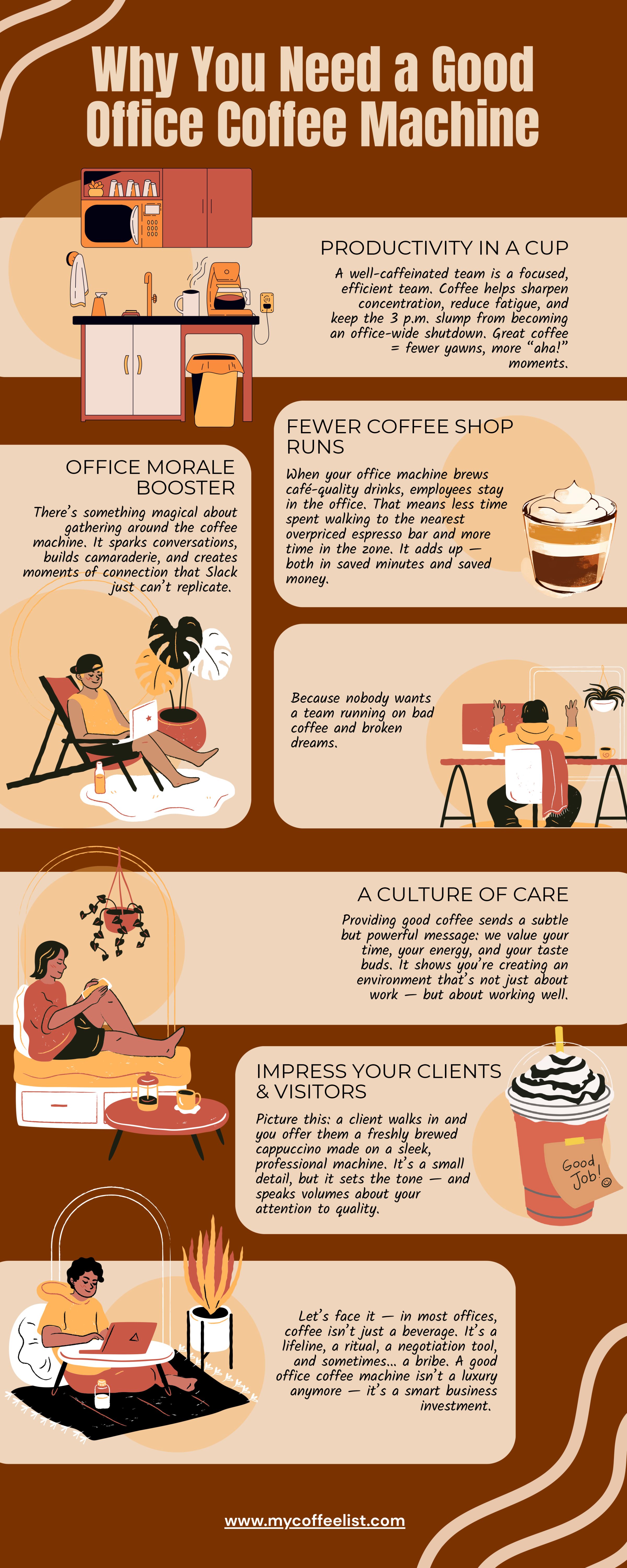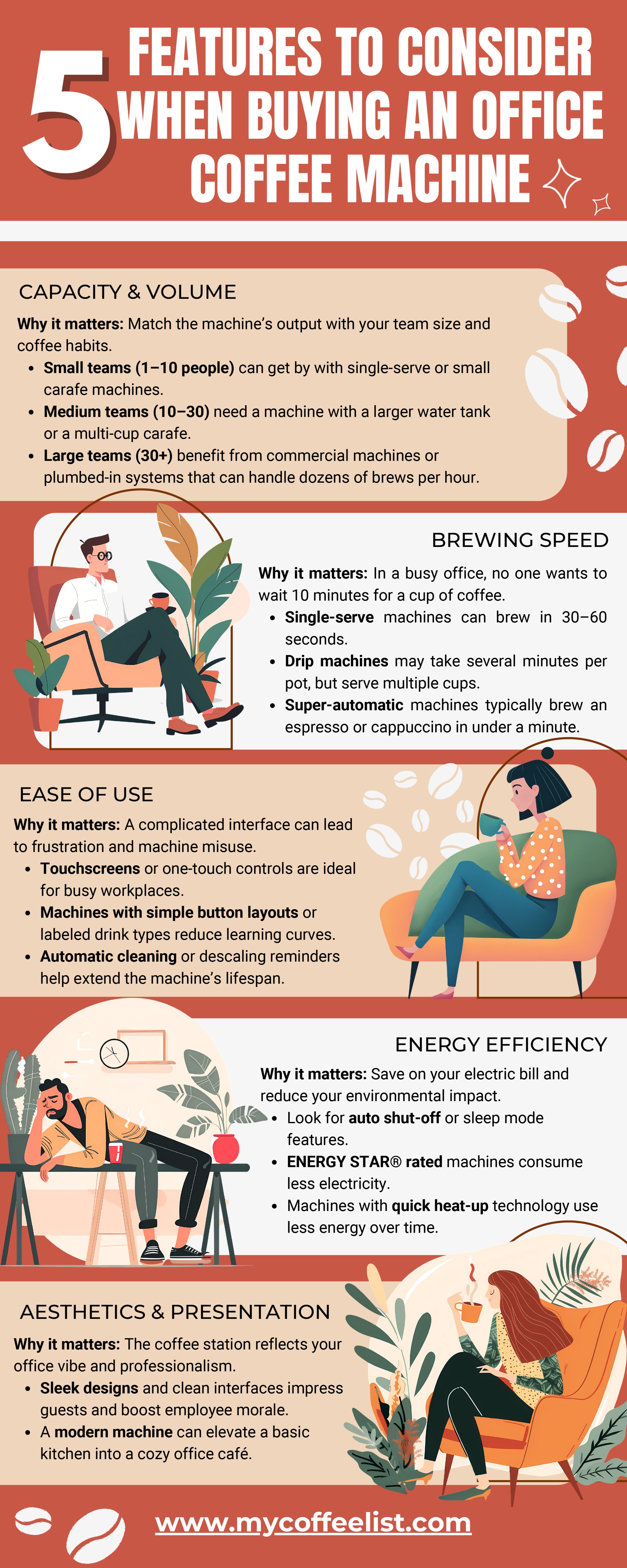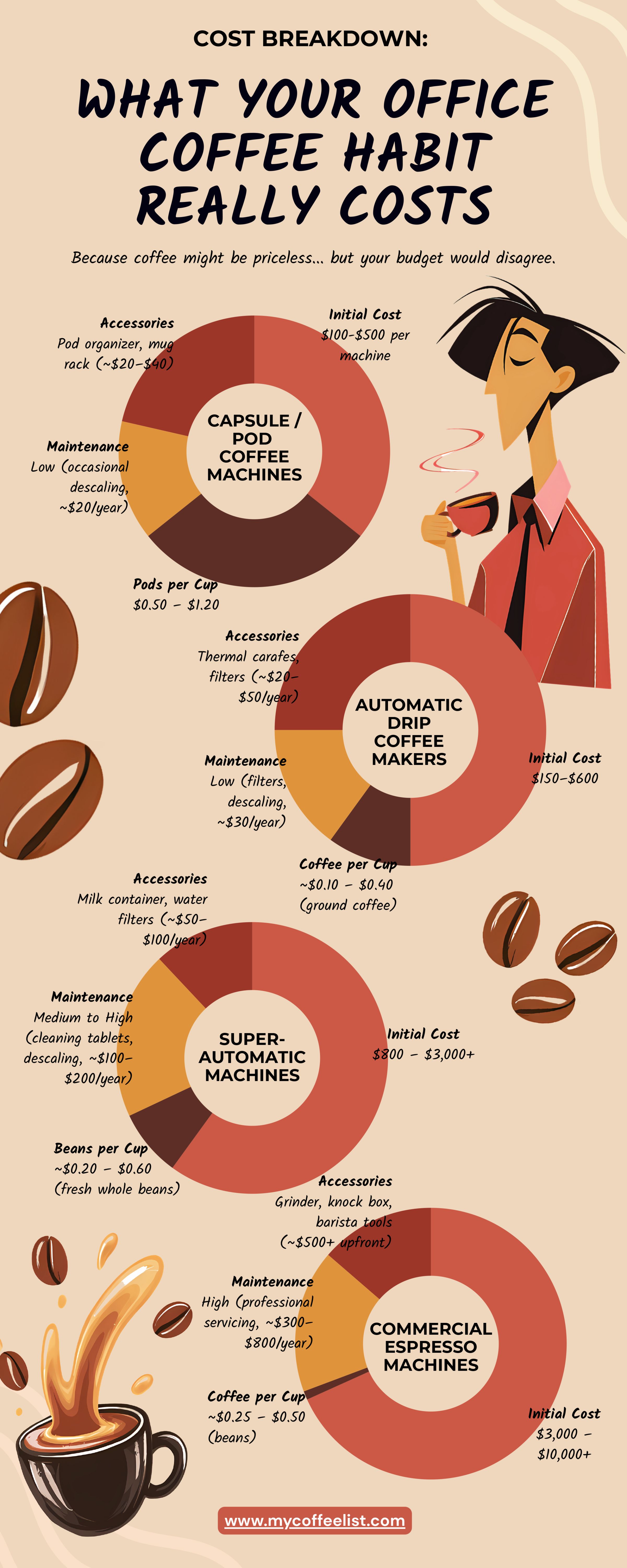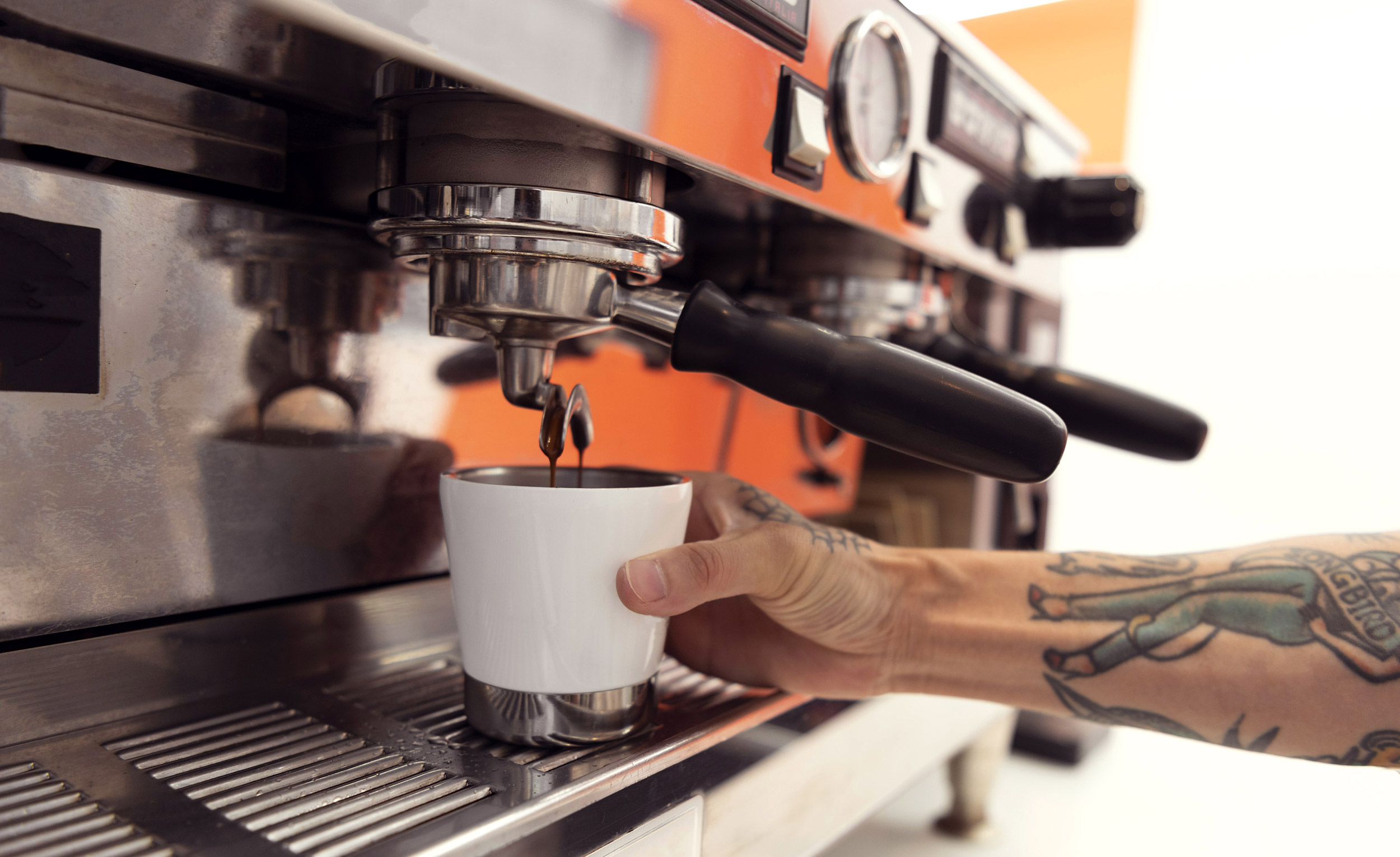Top Coffee Machines for the Office: From Small Startups to Big Teams
Coffee is the unofficial fuel of every modern workplace — from scrappy startups to buzzing co-working hubs to buttoned-up boardrooms. These days, a reliable office coffee machine isn’t a luxury; it’s essential equipment. But with so many options out there (grinders! frothers! touchscreen everything!), finding the one can feel more confusing than your Monday morning calendar.
In this guide, we break down the best office coffee machines based on team size, coffee preferences, and functionality, so you can keep your crew caffeinated — and happy.
Why Your Office Deserves Better Coffee Machines
Because nobody wants a team running on bad coffee and broken dreams.
Let’s face it — in most offices, coffee isn’t just a beverage. It’s a lifeline, a ritual, a negotiation tool, and sometimes... a bribe. A good office coffee machine isn’t a luxury anymore — it’s a smart business investment. Here's why:
1. Productivity in a Cup
A well-caffeinated team is a focused, efficient team. Coffee helps sharpen concentration, reduce fatigue, and keep the 3 p.m. slump from becoming an office-wide shutdown. Great coffee = fewer yawns, more “aha!” moments.
Bad coffee? That just leads to longer breaks and more grumbling at the water cooler.
2. Office Morale Booster
There’s something magical about gathering around the coffee machine. It sparks conversations, builds camaraderie, and creates moments of connection that Slack just can’t replicate. A good machine says, "Hey, we care about you — and your caffeine habits."
Perks like great coffee can actually increase job satisfaction. And no, we’re not just saying that — studies back it up.
3. Fewer Coffee Shop Runs
When your office machine brews café-quality drinks, employees stay in the office. That means less time spent walking to the nearest overpriced espresso bar and more time in the zone. It adds up — both in saved minutes and saved money.
Multiply 15 minutes by a few employees per day, five days a week… you’ll see the ROI pretty quickly.
4. Impress Your Clients & Visitors
Picture this: a client walks in and you offer them a freshly brewed cappuccino made on a sleek, professional machine. It’s a small detail, but it sets the tone — and speaks volumes about your attention to quality.
Bonus points if your machine makes that satisfying “hiss” from a milk frother. Instant credibility.
5. A Culture of Care
Providing good coffee sends a subtle but powerful message: we value your time, your energy, and your taste buds. It shows you’re creating an environment that’s not just about work — but about working well.
After all, it’s the little things (like coffee) that make a workplace feel human.
Bottom Line:
A solid office coffee setup isn’t just about caffeine — it’s about culture, performance, and creating a space people enjoy working in. Because when the coffee’s good, everything else feels just a little bit better.
Types of Coffee Machines for Offices
Each office has unique needs. Let’s break down the main types of coffee machines and who they’re best for.
1. Single-Serve Capsule Machines
Best for: Small teams (1–10 people), low maintenance environments.
Examples: Nespresso, Keurig, Lavazza
Pros:
- Fast and easy to use
- Minimal cleanup
- Wide variety of drink options
Cons:
- Higher cost per cup
- Environmental impact from pods
2. Automatic Drip Coffee Makers
Best for: Mid-sized offices with steady coffee drinkers.
Examples: BUNN, Technivorm Moccamaster
Pros:
- Brews multiple cups at once
- Cost-effective
- Reliable for daily use
Cons:
- Limited variety (usually just black coffee)
- Coffee can go stale if left sitting
3. Bean-to-Cup / Super-Automatic Espresso Machines
Best for: Offices that value quality and variety, or client-facing teams.
Examples: Jura, Saeco, De’Longhi, Franke
Pros:
- Grinds fresh beans per cup
- Makes espresso, lattes, cappuccinos, etc.
- One-touch convenience
Cons:
- Higher upfront cost
- Requires occasional maintenance
4. Commercial Espresso Machines
Best for: Large offices or shared office spaces with 50+ people.
Examples: Nuova Simonelli, La Marzocco, WMF
Pros:
- Designed for high volume use
- Consistent, café-quality drinks
- Impresses guests and clients
Cons:
- Expensive
- Requires barista skills or training
- Often needs to be plumbed in
Features to Consider When Buying an Office Coffee Machine
Choosing the right office coffee machine goes beyond price and aesthetics. The real value lies in how well it serves your team’s daily routine, preferences, and space. Here’s a breakdown of the key features to evaluate before making a purchase:
1. Capacity & Volume
Why it matters: Match the machine’s output with your team size and coffee habits.
- Small teams (1–10 people) can get by with single-serve or small carafe machines.
- Medium teams (10–30) need a machine with a larger water tank or a multi-cup carafe.
- Large teams (30+) benefit from commercial machines or plumbed-in systems that can handle dozens of brews per hour.
Look for brew cycle speed and water tank size as indicators of capacity.
2. Brewing Speed
Why it matters: In a busy office, no one wants to wait 10 minutes for a cup of coffee.
- Single-serve machines can brew in 30–60 seconds.
- Drip machines may take several minutes per pot, but serve multiple cups.
- Super-automatic machines typically brew an espresso or cappuccino in under a minute.
Choose faster machines for high-traffic offices or morning rush hours.
3. Drink Variety
Why it matters: Not everyone drinks their coffee the same way.
- Some machines only offer black coffee or espresso.
- Others can make lattes, cappuccinos, mochas, hot chocolate, and even tea.
- Consider whether your team prefers simple brews or café-style drinks.
Machines with built-in milk frothers or multiple beverage options offer more flexibility.
4. Ease of Use
Why it matters: A complicated interface can lead to frustration and machine misuse.
- Touchscreens or one-touch controls are ideal for busy workplaces.
- Machines with simple button layouts or labeled drink types reduce learning curves.
- Automatic cleaning or descaling reminders help extend the machine’s lifespan.
Consider ease of use especially if your office has frequent visitors or shared access.
5. Maintenance Requirements
Why it matters: Nobody wants to be the person cleaning the coffee machine every day.
- Single-serve and drip machines require minimal upkeep (pod disposal or filter rinse).
- Super-automatic and espresso machines may need daily or weekly cleaning of the milk system, descaling, and drip tray maintenance.
- Commercial machines often have built-in cleaning programs but still need regular service.
Look for self-cleaning features or models with dishwasher-safe parts for convenience.
6. Built-In Grinder
Why it matters: Freshly ground beans = fresher, better-tasting coffee.
- Many super-automatic espresso machines include a built-in grinder.
- Some drip coffee machines offer grind & brew functionality.
- If not built-in, consider buying a separate grinder for quality improvement.
Choose a burr grinder for consistency if using whole beans.
7. Water Source
Why it matters: Your water setup determines how often the machine needs refilling.
- Reservoir-fed machines require manual refills — fine for small teams.
- Plumbed-in machines connect to a water line — ideal for large offices or high-volume usage.
Offices with busy kitchens may benefit from plumbing in to avoid refilling multiple times per day.
8. Size & Footprint
Why it matters: The breakroom isn’t infinite.
- Measure your countertop space and check machine dimensions.
- Consider vertical height (especially under cabinets) and clearance for opening lids or removing water tanks.
- Think about placement near a power outlet and water source if needed.
Compact machines are great for tight spaces, but don’t sacrifice key features.
9. Energy Efficiency
Why it matters: Save on your electric bill and reduce your environmental impact.
- Look for auto shut-off or sleep mode features.
- ENERGY STAR® rated machines consume less electricity.
- Machines with quick heat-up technology use less energy over time.
Small savings on energy can add up over the year, especially in large offices.
10. Customization Options
Why it matters: Everyone has their “perfect cup.”
- Ability to control brew strength, temperature, cup size, and milk texture is a huge plus.
- User profiles (on high-end machines) allow employees to save their preferred drink settings.
- Some machines even integrate with mobile apps for touchless control.
The more customizable, the more satisfaction across a diverse team.
11. Aesthetics & Presentation
Why it matters: The coffee station reflects your office vibe and professionalism.
- Sleek designs and clean interfaces impress guests and boost employee morale.
- A modern machine can elevate a basic kitchen into a cozy office café.
Pro tip: Match your machine's color and materials with your breakroom style for a unified look.
Before you purchase, survey your team about their coffee habits — do they prefer espresso, black coffee, or lattes? Knowing their preferences can guide your decision and ensure your investment pays off in productivity and satisfaction.
Best Coffee Machines by Office Size
Small Teams (1–10 people)
-
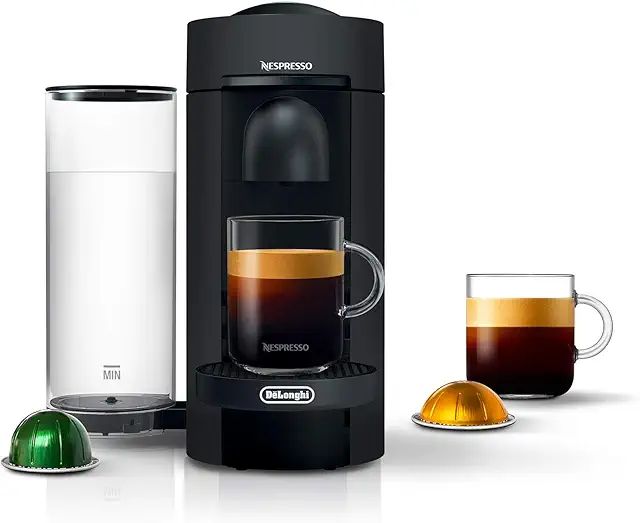
Nespresso VertuoPlus: Compact, fast, and user-friendly (from $169)
-
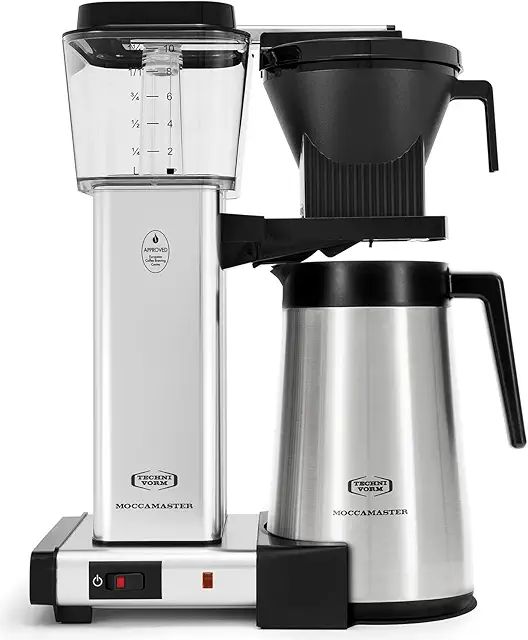
Technivorm Moccamaster: Premium drip coffee with consistent taste. (from $339)
-
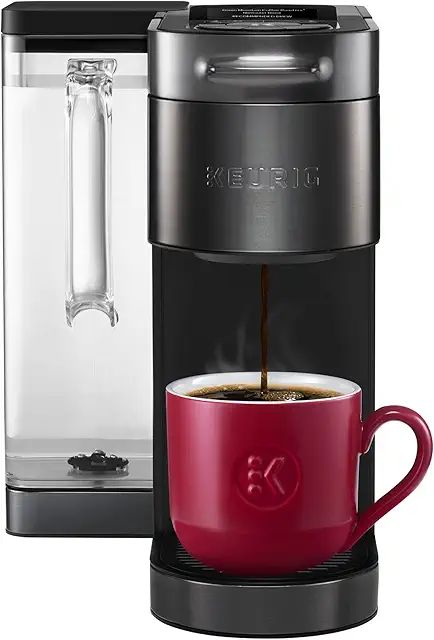
Keurig K-Supreme Plus SMART: Easy customization and variety (from $182)
Medium Teams (10–30 people)
-

Jura E6 / E8: Bean-to-cup with customizable drinks (from $1,899)
-
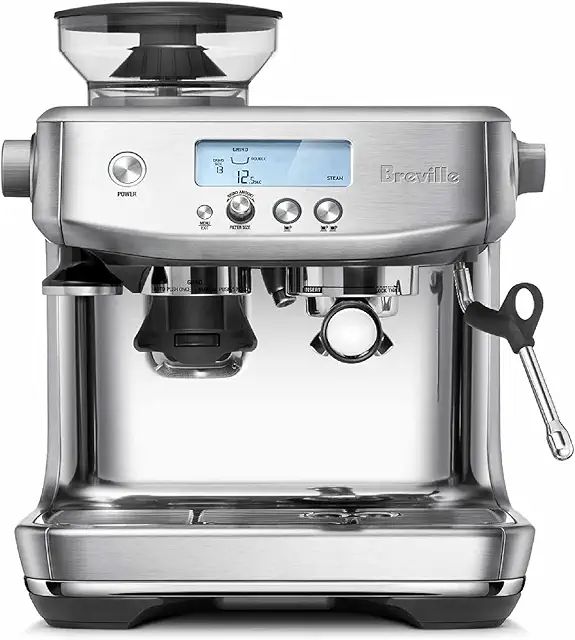
Breville Barista Pro: Great for espresso lovers with barista skills (from $721)
-
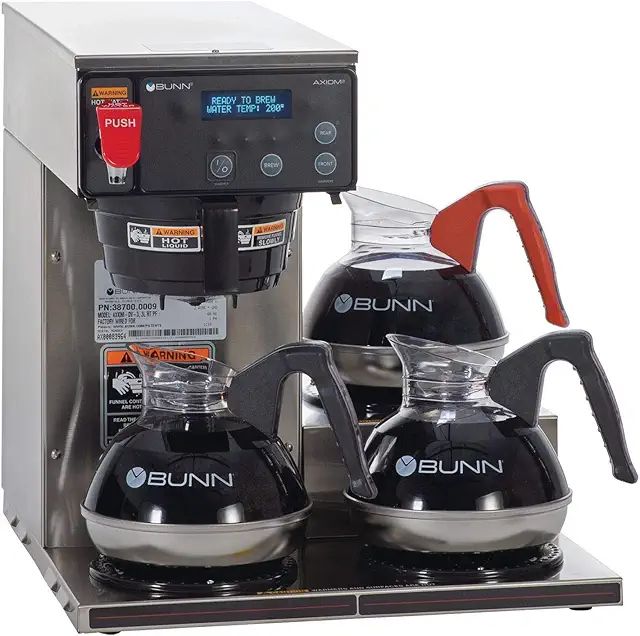
BUNN Axiom: Reliable, high-capacity drip brewer (from $863)
Large Teams (30+ people)
-
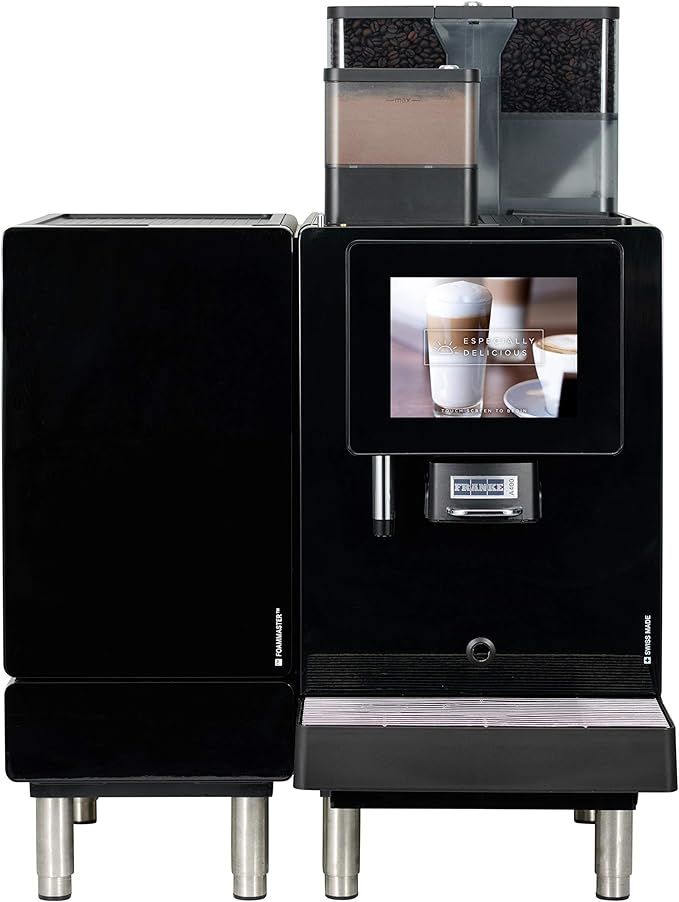
Franke A400: Touchscreen, self-cleaning, plumbed-in espresso machine
-
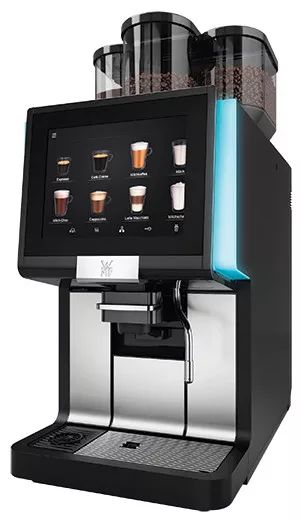
WMF 1500 S+: Up to 180 cups per day with milk and flavor options
-
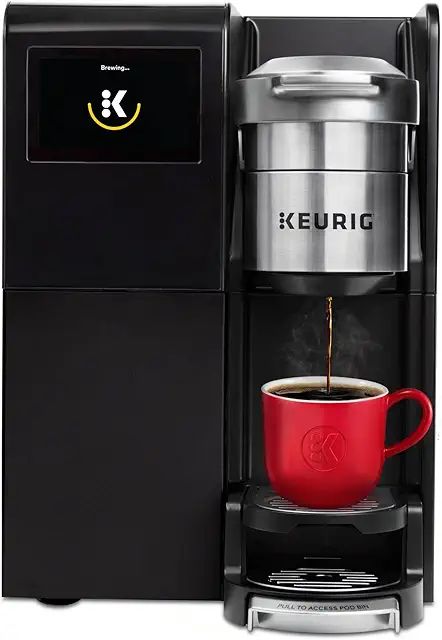
Keurig K-3500: Dual reservoir, fast brewing, large-capacity pod system (from $1,799)
Cost Breakdown: What Your Office Coffee Habit Really Costs
Because coffee might be priceless... but your budget would disagree.
We all know that great coffee is worth every penny — but how many pennies are we actually talking about?
Before you commit to that shiny new espresso machine (or stockpile single-serve pods like it’s the caffeine apocalypse), it’s smart to understand the real cost of fueling your office’s coffee cravings.
From upfront machine prices to the sneaky little costs like maintenance, filters, and milk frothers, this section breaks down what you’ll spend — and where you’ll save — based on the type of coffee machine you choose.
Spoiler alert: some machines look cheap at first, but they’re sneaky little budget vampires over time. Others? They might seem expensive but save you money in the long run.
Let’s break it all down — beans, bucks, and brews.
1. Capsule / Pod Coffee Machines
Examples: Nespresso, Keurig, Lavazza Blue
| Category | Cost Estimate |
|---|---|
| Initial Cost | $100–$500 per machine |
| Pods per Cup | $0.50 – $1.20 |
| Maintenance | Low (occasional descaling, ~$20/year) |
| Accessories | Pod organizer, mug rack (~$20–$40) |
Pros: Low upfront cost, easy to use, minimal cleaning
Cons: High long-term cost per cup, waste from pods
Best for: Small offices with limited counter space or light coffee consumption.
2. Automatic Drip Coffee Makers
Examples: BUNN, Technivorm Moccamaster, Cuisinart
| Category | Cost Estimate |
|---|---|
| Initial Cost | $150–$600 |
| Coffee per Cup | ~$0.10 – $0.40 (ground coffee) |
| Maintenance | Low (filters, descaling, ~$30/year) |
| Accessories | Thermal carafes, filters (~$20–$50/year) |
Pros: Inexpensive to run, brews multiple cups at once
Cons: Less variety, stale coffee if left on warmer
Best for: Mid-sized teams that drink mostly black coffee.
3. Bean-to-Cup / Super-Automatic Machines
Examples: Jura, De’Longhi, Saeco, Gaggia
| Category | Cost Estimate |
|---|---|
| Initial Cost | $800 – $3,000+ |
| Beans per Cup | ~$0.20 – $0.60 (fresh whole beans) |
| Maintenance | Medium to High (cleaning tablets, descaling, ~$100–$200/year) |
| Accessories | Milk container, water filters (~$50–$100/year) |
Pros: Café-style drinks at the press of a button
Cons: Higher upfront and maintenance costs
Best for: Offices with diverse coffee preferences and a love for quality espresso drinks.
4. Commercial Espresso Machines
Examples: La Marzocco, WMF, Nuova Simonelli, Franke
| Category | Cost Estimate |
|---|---|
| Initial Cost | $3,000 – $10,000+ |
| Coffee per Cup | ~$0.25 – $0.50 (beans) |
| Maintenance | High (professional servicing, ~$300–$800/year) |
| Accessories | Grinder, knock box, barista tools (~$500+ upfront) |
Pros: Handles high volume, barista-quality drinks
Cons: Expensive, requires staff training and ongoing servicing
Best for: Large offices, co-working spaces, or companies that host clients regularly.
Cost Comparison at a Glance
| Machine Type | Initial Cost | Cost per Cup | Maintenance | Best For |
|---|---|---|---|---|
| Capsule/Pod | $100–$500 | $0.50–$1.20 | Low | Small teams, low usage |
| Drip | $150–$600 | $0.10–$0.40 | Low | Black coffee drinkers |
| Bean-to-Cup | $800–$3,000+ | $0.20–$0.60 | Medium | Quality + convenience |
| Commercial Espresso | $3,000–$10K+ | $0.25–$0.50 | High | High volume, client-facing |
Other Hidden or Recurring Costs to Consider
Maintenance & Repairs
- Cleaning kits or tablets: $10–$50
- Descaling agents: $15–$30
- Water filters: $20–$60/year
- Annual servicing (for high-end machines): $300+
Consumables
- Coffee beans or grounds
- Milk (if applicable)
- Sugar, creamer, stirrers
- Paper filters or reusable accessories
Energy Use
- Some machines stay heated all day; look for energy-saving modes or auto shut-off features.
Cost-Saving Tips
- Buy in bulk: Purchase beans, pods, and filters in bulk to reduce per-unit cost.
- Encourage reusable mugs: Cut down on disposable cup costs.
- Track usage: See how much coffee is being consumed — you may not need as much machine as you think.
- Consider refurbished machines: For high-end options at lower prices, look for certified refurbished models.
While upfront costs vary, calculating the total cost of ownership (TCO) — including per-cup cost, maintenance, and lifespan — will give you a clearer picture of long-term value. A machine that costs more initially, may save you money in the long run if it's efficient and well-matched to your team's needs.
| Machine Type | Price Range | Per Cup Cost | Maintenance |
|---|---|---|---|
| Capsule | $100–$500 | $0.70–$1.20 | Low |
| Drip | $150–$600 | $0.15–$0.40 | Low |
| Bean-to-Cup | $800–$3000 | $0.30–$0.60 | Medium |
| Commercial Espresso | $3000–$10,000+ | $0.25–$0.50 | High |
Sustainability Tips
Want to keep your coffee habit green?
- Use recyclable or refillable pods
- Choose machines with energy-saving modes
- Offer ceramic mugs instead of disposable cups
- Work with roasters that supply ethically sourced beans
How to Choose the Right Coffee Machine (Without Losing Your Mind)
After all the specs, features, pros, cons, and coffee-fueled comparisons, you might still be thinking:
"Okay... but which one do I actually buy?"
Don't worry — choosing the right office coffee machine doesn't require a barista certification or a spreadsheet with 47 columns. (Although if you're into that... we respect it.)
Ask yourself these questions before buying:
- How many people will use it daily?
- Do we want variety (lattes, cappuccinos) or just good black coffee?
- Do we have space and a water line?
- What’s our budget for the machine and upkeep?
The right office coffee machine doesn’t just brew coffee — it boosts focus, fuels team vibes, and cuts down on those mid-morning café runs. Whether you’ve got five people or five hundred, there’s a machine out there ready to make your coffee breaks smoother, smarter, and a whole lot tastier.
Pro Tip: Invest in a machine that’s slightly above your current size — your team (and their coffee needs) will grow!
